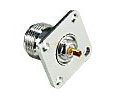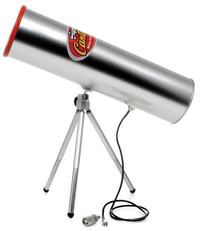Vermes
Advanced Member level 4
A WiFi antenna is a wireless network that provides communication between more than two computers which keep the Internet connectivity aside. In simple words, a WiFi allows you to exchange data between a few devices wirelessly at a certain range (usually it is from 50 to 100 meters in factory devices, depending on the type). The word WiFi uses radio waves. A device using WiFi is able to connect to the network though an access points also called hotspot. The range of such hotspot is smaller inside a room and greater in the open air. WiFi connection can be less secure than connections that use wire, because everyone can enter it without a physical connection.
WiFi at home makes it possible to connect devices of personal use, such as PC, game console and laptop. It can be useful when more than 2 people want to share their data, files or photos in the range of this connection. Another advantage is that there is no wires so this solution is more aesthetic one.
Creating a WiFi antenna of own construction isn't a hard thing, below we'll present some methods how to make it.
Approach 1:
You can built a WiFi antenna on your own using easily available and cheap components.
What will you need to create the so-called cantenna:
-one can
-connector



-some nuts and bolts
-wire
Using the can allows you to highly reduce costs of your construction. First thing you should do is to open, empty, wash and dry the can. Its diameter should be around 3” and less than 4”, but if you do not have a can of this size, it can be greater than that. Then mount the N-Female connector in the side of the can. You have to calculate its location using the frequency at which your cantenna is to operate and the diameter of can used in your version. Special calculators for this purpose can be found on the Internet. When the calculations are ready, make a hole for the connector. You can make it using a drill, but if you do not have one, you can use a nail to start the hole and then files to enlarge it until it gets desired size. Do not forget to make four additional holes for the bolts. After that, the wire should be cut so that the length of the wire that protrudes out of the connector and brass tube will be about 1,21”. Next, solder the wire into the connector and wait until it cools down. Then put everything in the can. Bolts heads should be placed inside and the nuts outside the can. At the end, connect the cantenna to a wireless card or hotspot and your device is ready to be used.
Picture of a cantenna:

Approach 2:
Parabolic WiFi antenna also can be made at home. It is used to improve the performance of your WiFi range. It can be made of wire mesh strainer. Then, cut an opening in its center and put the USB adapter in such created parabola. That will improve the signal strength by 12 to 15dB. Connect the cables and configure the device.
Approach 3:
Homemade coax antenna is a kind of telescope for radio waves and thus it is perfect for extending the range of WiFI.
Elements you will need:
-sticks
-glue
-wire
-soldering iron and lead
-tools like scissors, pliers, mm ruler
Pattern of the antenna can be downloaded from the Internet, then print it on an ink jet printer, remembering about the scale of the picture. It may be helpful to use an accurate ruler with mm to measure whether the print fits perfectly the desired scale. Next, cut the pieces of wire to the appropriate size and then bend, in order to glue them to the printed pattern. Using sticks, create the backbone of your antenna. It is very important to make sure that all the elements fit perfectly. At the end, the only thing you have to do is to connect the USB to the read antenna.
Coax WiFi antenna:

Maybe these ideas will help you to improve the performance and extend range of your WiFi in an inexpensive way.
WiFi at home makes it possible to connect devices of personal use, such as PC, game console and laptop. It can be useful when more than 2 people want to share their data, files or photos in the range of this connection. Another advantage is that there is no wires so this solution is more aesthetic one.
Creating a WiFi antenna of own construction isn't a hard thing, below we'll present some methods how to make it.
Approach 1:
You can built a WiFi antenna on your own using easily available and cheap components.
What will you need to create the so-called cantenna:
-one can
-connector



-some nuts and bolts
-wire
Using the can allows you to highly reduce costs of your construction. First thing you should do is to open, empty, wash and dry the can. Its diameter should be around 3” and less than 4”, but if you do not have a can of this size, it can be greater than that. Then mount the N-Female connector in the side of the can. You have to calculate its location using the frequency at which your cantenna is to operate and the diameter of can used in your version. Special calculators for this purpose can be found on the Internet. When the calculations are ready, make a hole for the connector. You can make it using a drill, but if you do not have one, you can use a nail to start the hole and then files to enlarge it until it gets desired size. Do not forget to make four additional holes for the bolts. After that, the wire should be cut so that the length of the wire that protrudes out of the connector and brass tube will be about 1,21”. Next, solder the wire into the connector and wait until it cools down. Then put everything in the can. Bolts heads should be placed inside and the nuts outside the can. At the end, connect the cantenna to a wireless card or hotspot and your device is ready to be used.
Picture of a cantenna:

Approach 2:
Parabolic WiFi antenna also can be made at home. It is used to improve the performance of your WiFi range. It can be made of wire mesh strainer. Then, cut an opening in its center and put the USB adapter in such created parabola. That will improve the signal strength by 12 to 15dB. Connect the cables and configure the device.
Approach 3:
Homemade coax antenna is a kind of telescope for radio waves and thus it is perfect for extending the range of WiFI.
Elements you will need:
-sticks
-glue
-wire
-soldering iron and lead
-tools like scissors, pliers, mm ruler
Pattern of the antenna can be downloaded from the Internet, then print it on an ink jet printer, remembering about the scale of the picture. It may be helpful to use an accurate ruler with mm to measure whether the print fits perfectly the desired scale. Next, cut the pieces of wire to the appropriate size and then bend, in order to glue them to the printed pattern. Using sticks, create the backbone of your antenna. It is very important to make sure that all the elements fit perfectly. At the end, the only thing you have to do is to connect the USB to the read antenna.
Coax WiFi antenna:

Maybe these ideas will help you to improve the performance and extend range of your WiFi in an inexpensive way.